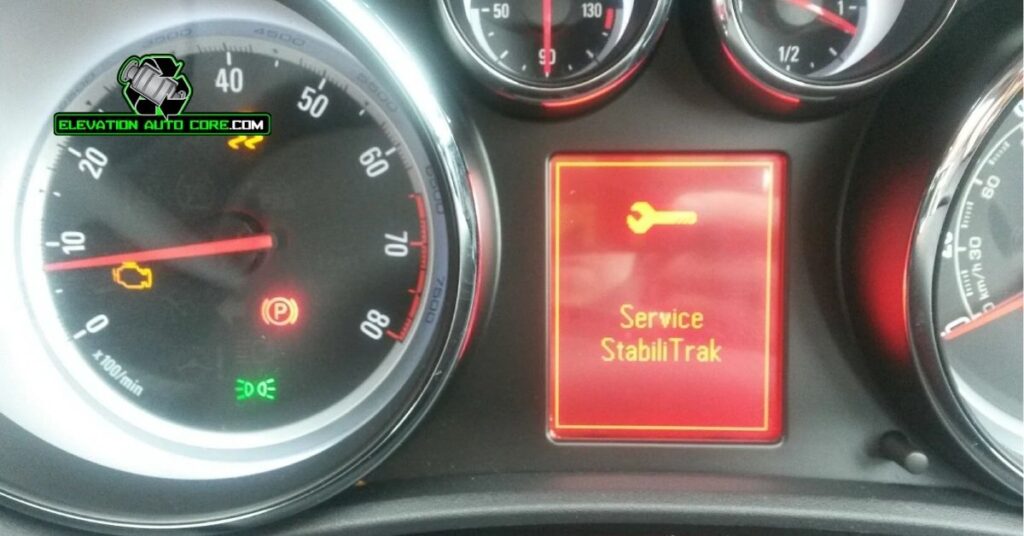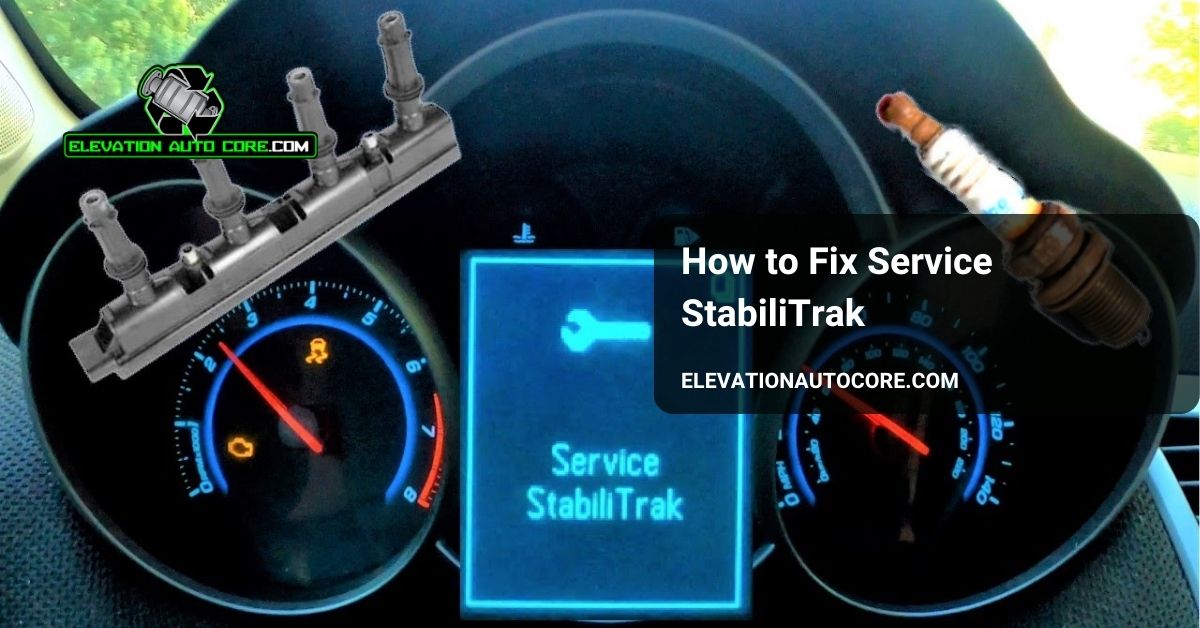Is your vehicle displaying a “Service StabiliTrak” warning, leaving you wondering what to do next? This common issue can affect your car’s stability system, but the good news is it’s often fixable without a trip to the mechanic. Stick around to learn simple steps to diagnose and resolve the problem, so you can get back on the road with confidence.
What Is Service StabiliTrak?

Service StabiliTrak refers to a warning system built into many modern vehicles. This system is part of the Electronic Stability Control (ESC) feature designed to assist drivers in maintaining control during adverse driving conditions. Its primary function is to enhance stability by reducing the risk of wheel slip.
The StabiliTrak system monitors factors like wheel rotation speed, steering angle, and vehicle yaw rate. If it detects a potential loss of traction, it applies brakes or adjusts engine power to stabilize your vehicle. You’ll see the “Service StabiliTrak” warning light when there’s a malfunction in this system.
Most General Motors (GM) vehicles, including Chevrolet and GMC models, include this technology. The notification often appears on the dashboard display, signaling an issue that needs immediate attention.
Common Causes Of Service StabiliTrak Warning
You might see the Service StabiliTrak warning for various reasons, often tied to sensor malfunctions or electrical system issues. Addressing these causes ensures the stability system works effectively.
Faulty Wheel Speed Sensors
Wheel speed sensors monitor the rotational speed of your vehicle’s wheels. A sensor malfunction can disrupt StabiliTrak’s ability to compare wheel speeds, which affects traction control. Debris or damage near the sensor area, such as around the brake or hub assembly, often leads to these faults. Ensure that you inspect or clean the sensor before considering replacement.
Malfunctioning Steering Angle Sensor
The steering angle sensor measures your steering wheel’s position and movement. StabiliTrak depends on accurate data from this sensor to regulate stability during turns. Incorrect calibration or internal failure in the sensor results in conflicting signals and triggers the warning. Recalibration or replacement might resolve this issue.
Issues With Electronic Brake Control Module (EBCM)
The EBCM controls the brake pressure adjustments under stability or traction events. A malfunctioning module can interrupt these adjustments, especially in critical moments, causing the StabiliTrak system to deactivate. Diagnosing EBCM failures often involves specialized equipment to detect error codes and performance anomalies.
Wiring And Connector Problems
Wires and connectors within the stability control system provide communication between the sensors and control modules. Corrosion, wear, or exposed wiring frequently disrupts signal relay, leading to the warning light activation. Inspections of connectors near wheel hubs, the sensor harness, and the EBCM can help pinpoint the root cause. Repairing or replacing damaged components restores system reliability.
How To Diagnose Service StabiliTrak Issues

Identifying the root cause of a Service StabiliTrak warning streamlines the repair process. Focus on key components like sensors, wiring, and the brake system to ensure accurate diagnostics.
Using An OBD II Scanner
Plug an OBD II scanner into the diagnostic port, usually located under the dashboard. Read the error codes displayed by the scanner, which point to exact issues like sensor malfunctions or module errors. Reference your vehicle’s service manual for code descriptions and repair instructions. Clear the codes after repairs to confirm if the issue persists.
Checking Sensor Connections And Wiring
Inspect all sensor connections, especially those for wheel speed and steering angle sensors. Loose or corroded connectors can cause communication failures within the stability control system. Trace the wiring harnesses for visible damage, such as fraying or pinches, which might disrupt signals. Replace any damaged components to restore system functionality.
Inspecting Brake System Components
Examine the brake system for signs of wear or damage. Pay close attention to the Electronic Brake Control Module, as malfunctions in this unit can impair stability control functions. Test the brake pressure sensors to confirm they’re operating correctly and replace any faulty components. Verify that brake fluid levels meet the manufacturer’s specifications, as insufficient fluid affects performance.
Step-By-Step Guide On How To Fix Service StabiliTrak

Fixing the Service StabiliTrak warning involves targeted troubleshooting. Follow these practical steps under exact problem areas to resolve the issue effectively.
Resetting The System
Start by turning off your vehicle. Wait for 15 seconds after shutting off the engine to allow system components to reset fully. Restart your car and check if the warning light disappears. If the light remains on, the problem may require further diagnostics. Temporary resets might not solve underlying issues, so confirm that the vehicle’s systems are functioning normally.
Replacing Faulty Sensors
Inspect sensors like the wheel speed sensor or steering angle sensor for damage. Faulty sensors cause inaccurate readings, resulting in the warning light. Use an OBD II scanner to identify which sensor is affected. Replace defective sensors with manufacturer-approved replacements for better compatibility. Sensor connections should also be secured to prevent recurrent issues.
Repairing Or Replacing Wiring And Connectors
Visually evaluate wiring and connectors linked to the stability system. Corrosion, frayed wires, or loose connections frequently disrupt system communication. Replace damaged wiring sections using appropriate tools to avoid further electrical issues. Ensure connectors are clean and tightly connected before testing the system again to verify repairs.
Updating Or Reprogramming Software
Certain Service StabiliTrak warnings stem from outdated software. Access your vehicle’s service manual to determine if software updates are required. Visit a dealership or authorized service center for updates or reprogramming when necessary. Updated software improves system performance and might resolve persistent errors after hardware fixes.
When To Seek Professional Help
Certain situations require professional assistance to address the Service StabiliTrak warning. Persistent warning signals after attempting basic fixes indicate a deeper issue. If resetting the system and replacing faulty sensors don’t resolve the problem, consult a certified mechanic.
Electrical problems, particularly with the Electronic Brake Control Module, often necessitate specialized tools. Technicians equipped with advanced diagnostic equipment can accurately pinpoint issues within the stability system.
Complex repairs, like reprogramming the vehicle’s software, are best handled in a professional setting. Insufficient expertise or improper handling could exacerbate the problem, leading to higher repair costs.
Safety concerns arise if the vehicle exhibits erratic handling or braking issues alongside the warning light. Seek immediate professional evaluation to ensure safe driving conditions.
Unexpected or recurring errors, even though following proper diagnostic steps, suggest hidden faults. Professionals can conduct thorough inspections to identify and fix less obvious defects.
Preventive Measures To Avoid StabiliTrak Issues

Regular maintenance reduces the likelihood of StabiliTrak system failures. Ensure sensors, including wheel speed and steering angle sensors, are inspected during routine services. Monitoring their connection points prevents corrosion or looseness that can disrupt system performance.
Keeping your electrical system in good condition minimizes malfunctions. Inspect and clean wiring, connectors, and ground points to avoid electrical issues. Address any visible damage immediately, as faulty wiring often complicates diagnostics and repairs.
Following the manufacturer’s service schedule keeps critical components, like the Electronic Brake Control Module, functional. Check the service manual for intervals exact to your vehicle model, especially for software updates or programming needs.
Driving with care in adverse conditions reduces strain on the StabiliTrak system. Avoid excessive braking, sharp turns, or rapid acceleration in snow, rain, or uneven terrain. Proper driving habits extend the life of vehicle stability systems.
Investing in a high-quality OBD II scanner can help detect minor problems before they evolve into important issues. Regularly scanning your vehicle for error codes ensures early detection and timely maintenance.
Conclusion
Addressing the Service StabiliTrak warning doesn’t have to be overwhelming. By understanding its causes and following practical troubleshooting steps, you can often resolve the issue on your own. Regular maintenance and proactive care will help keep your vehicle’s stability system functioning reliably, giving you peace of mind on the road.
If basic fixes don’t resolve the problem or safety concerns arise, don’t hesitate to seek professional assistance. Prioritizing your vehicle’s health ensures not only a smoother driving experience but also your safety and that of others.

